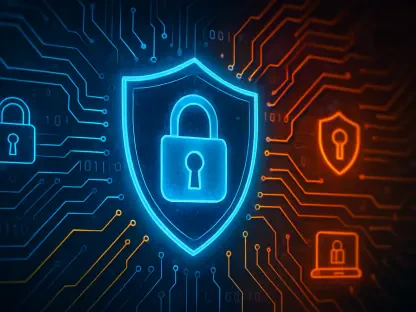In a world where digital transformation drives innovation and operational efficiency, businesses increasingly find themselves contending with a broad spectrum of rapidly evolving cyber threats. The pace at which these threats develop and infiltrate systems poses significant challenges, making it imperative for organizations to comprehend and counter these risks effectively. This discussion will delve into the dynamic landscape of cyber threats that modern enterprises face and present strategies they can adopt to fortify their defenses against these ever-present dangers.
The Current Threat Landscape
Understanding Cyber Attacks
As organizations embrace digital advancements, cyberattacks are growing in sophistication, utilizing diverse and intricate techniques to compromise systems. Attackers exploit zero-day vulnerabilities—previously unknown software defects for which patches are unavailable—jeopardizing the security of targeted infrastructures. Recent incidents have seen cybercriminals leveraging these exploits to infiltrate firewalls and deploy stealthy malware such as the notorious “Baldwin Killer,” a malware variant renowned for its advanced evasion capabilities. This malware cunningly circumvents traditional antivirus solutions and endpoint detection systems, making timely patching and vigilance crucial to thwarting such threats. Given the diversity of attack methodologies, businesses must prioritize regular system updates and maintain awareness of emerging vulnerabilities to ensure their systems are not susceptible to unauthorized access or compromise.
Exploitation of Vulnerabilities
Cyber threats increasingly target small and medium-sized businesses (SMBs) by exploiting vulnerabilities in network edge devices such as firewalls and VPNs, which can lead to significant breaches if left unpatched. Malicious actors recognize these areas as potential weak points and seize opportunities to exploit them. Open-source platforms have become attractive channels for criminals to disseminate malicious packages masquerading as legitimate developer tools. These packages often contain backdoors designed for data exfiltration, raising serious concerns about the integrity of software supply chains. Recognizing these vulnerabilities is just one step in a larger process that necessitates implementing robust security measures and practices, such as diligent patch management and thorough vetting of software dependencies. Companies need to take decisive action not only to protect their own assets but also to safeguard their customers and stakeholders from the cascading effects of breaches originating within compromised supply chains.
Adaptive Defense Strategies
Enhancing Traditional Security Measures
The contemporary cybersecurity landscape requires businesses to shore up traditional defense mechanisms by implementing comprehensive measures that adapt to the changing threat environment. Key to this strategy is maintaining up-to-date patching schedules alongside a repository of threat intelligence aimed at preempting known and emerging threats. Organizations should emphasize building a security-conscious culture through regular staff training and awareness programs that align employees with best practices in cybersecurity. This cultural emphasis not only mitigates the risk of human error—which often serves as a gateway for attacks—but also cultivates a proactive approach to defense, encouraging constant vigilance and layered security measures.
Advanced Security Solutions
Artificial intelligence (AI) and machine learning have emerged as powerful allies in identifying and neutralizing sophisticated cyber threats, allowing for preemptive actions once inconceivable. These technologies analyze vast datasets to detect anomalies indicative of potential breaches, enabling quicker and more accurate responses. In conjunction, deploying next-generation security solutions, including advanced endpoint protection and multifactor authentication, significantly reduces the risk of unauthorized access. These tools offer enhanced detection capabilities and automate routine tasks, alleviating resource constraints and allowing cybersecurity professionals to focus on strategic threat management rather than mundane processes. Continuous integration of such technologies is pivotal in maintaining a resilient defense posture capable of adapting to both current and future cyber threats.
Cloud and IoT Security Challenges
Battling Cloud-Based Threats
The adoption of cloud computing solutions has introduced new dimensions of threat vectors, prompting businesses to develop stringent security protocols specifically tailored for cloud environments. Cybercriminals exploit cloud vulnerabilities, often resulting in unauthorized access and data breaches that can be catastrophic to both reputation and financial health. Organizations must develop comprehensive security strategies that include stringent access controls, regular security audits, and robust encryption mechanisms. Employing security tools that offer visibility across the cloud infrastructure enables continuous monitoring and prompt response to potential threats, serving as a bulwark against breaches.
IoT Vulnerabilities and Countermeasures
The proliferation of Internet of Things (IoT) devices introduces unique vulnerabilities that are enticing to cybercriminals due to often inadequate security measures. These devices, from consumer gadgets to industrial equipment, can serve as entry points for gaining access to larger, more secure networks. To counteract these vulnerabilities, robust authentication methods combined with continuous monitoring are essential. Organizations should adopt security frameworks tailored for IoT ecosystems, including the use of secure boot mechanisms to ensure the integrity of connected devices at startup. Monitoring network traffic for anomalies and implementing network segmentation can help isolate and mitigate the impact of potential breaches, reinforcing the collective security posture of IoT-enabled networks.
Data Breaches and Regulatory Compliance
Protecting Sensitive Data
In recent years, data breaches have underscored the significance of implementing stringent data protection measures that address both preventative and responsive aspects of cybersecurity. Organizations dealing with sensitive information must employ robust encryption techniques and access controls that restrict data access to authorized users only. Regular vulnerability assessments and security audits provide insights into potential weaknesses, allowing for timely rectification. Additionally, businesses should develop incident response plans to quickly manage breaches, minimizing their impact and ensuring continuity of operations. Adopting these strategies affirms commitment to safeguarding sensitive information, fortifying trust among clients and stakeholders.
The Role of Regulatory Frameworks
Compliance with regulatory frameworks, such as the Health Insurance Portability and Accountability Act (HIPAA) and the General Data Protection Regulation (GDPR), plays a crucial role in dictating how businesses handle and protect data. These regulations mandate stringent processes for data management, compelling organizations to adopt comprehensive cybersecurity measures. Adhering to these frameworks not only ensures compliance but also reinforces industry standards for data protection, offering a competitive advantage. Regularly reviewing and updating compliance processes in alignment with regulatory changes is essential to maintain adherence and safeguard digital assets. Engaging in this dynamic process underscores the importance of proactive security management and bolsters confidence in the organization’s ability to handle sensitive data responsibly.
Supply Chain and Infrastructure Security
Securing the Software Supply Chain
The integrity of the software supply chain has become a focal point for cybersecurity strategies, as malicious packages introduced into open-source repositories can compromise an entire system’s security. Businesses must implement stringent due diligence procedures, rigorously vet software components for potential vulnerabilities, and ensure that dependencies are secure. Encouraging the use of signed code and checksum validation prevents tampering and guarantees authenticity throughout the software development lifecycle. These practices, alongside continuous monitoring for unusual activity, can significantly minimize risks associated with supply chain compromises.
Strengthening Network and Retail Infrastructure
In today’s world, as digital transformation propels innovation and increases operational efficiency, businesses grapple with a wide range of evolving cyber threats. These threats are not static; they develop rapidly, presenting substantial challenges for organizations. This makes it crucial for businesses to thoroughly understand and effectively address these risks. As companies integrate more digital solutions into their operations, their vulnerability to cyber-attacks increases. Hackers and malicious actors are continuously developing sophisticated methods to exploit system weaknesses, making it essential for enterprises to stay a step ahead.
Cybersecurity is no longer just an IT concern but a critical business function requiring attention from all levels within an organization. Companies must adopt a proactive approach, implementing robust security measures like firewalls, encryption, and multi-factor authentication. Regular training for employees on recognizing phishing attempts and safe internet practices is also vital. Additionally, businesses should conduct periodic security audits to identify and rectify potential vulnerabilities.
By fostering a culture of vigilance and prioritizing cybersecurity, organizations can better protect their assets and maintain customer trust. In an era where cyber threats are an ever-present danger, staying informed and prepared is key to safeguarding an enterprise’s future success.









